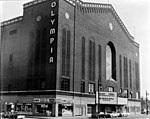Rosa Parks Flat
African-American history in DetroitHistory of civil rights in the United StatesNational Register of Historic Places in DetroitRosa Parks

The Rosa L. (McCauley) and Raymond Parks Flat, or simply the Rosa Parks Flat, is a two-story brick duplex located at 3201-3203 Virginia Park Street in Detroit, Michigan. The building is significant as the home of civil rights icon Rosa Parks, who lived in the first floor flat with her husband Raymond from 1961 to 1988. The building was listed on the National Register of Historic Places in 2021.
Excerpt from the Wikipedia article Rosa Parks Flat (License: CC BY-SA 3.0, Authors, Images).Rosa Parks Flat
Virginia Park Street, Detroit
Geographical coordinates (GPS) Address Nearby Places Show on map
Geographical coordinates (GPS)
| Latitude | Longitude |
|---|---|
| N 42.364444444444 ° | E -83.109722222222 ° |
Address
Rosa Parks Flat
Virginia Park Street 3201, 3203
48206 Detroit
Michigan, United States
Open on Google Maps







